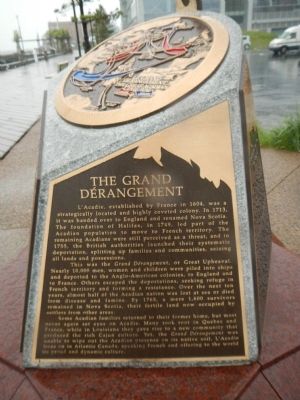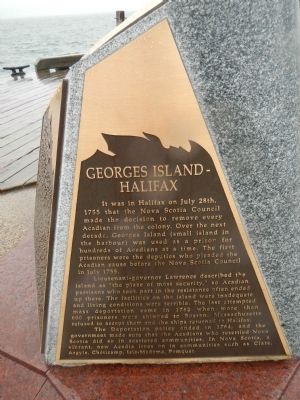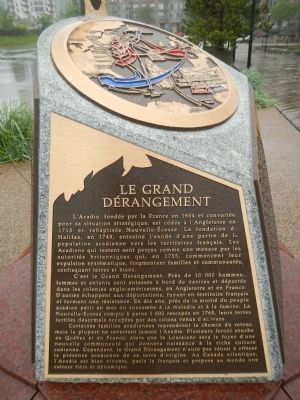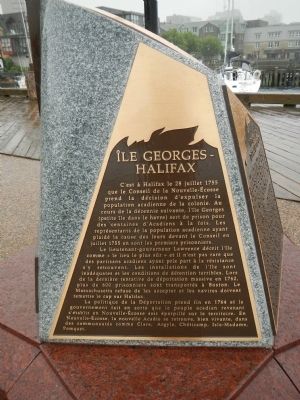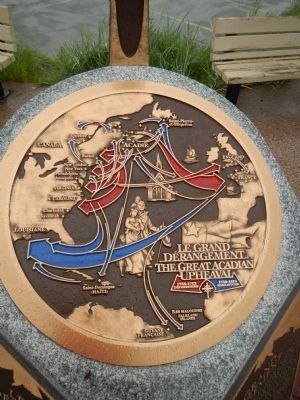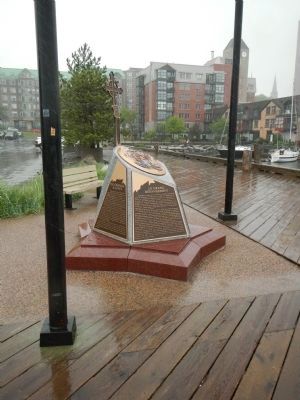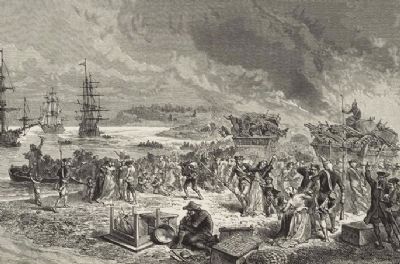Halifax in Halifax Region, Nova Scotia — The Atlantic Provinces (North America)
The Grand Dérangement
Georges Island - Halifax / Île Georges - Halifax
English
The Grand Dérangement
L’Acadie, established by France in 1604, was a strategically located and highly coveted colony. In 1713, it was handed over to England and renamed Nova Scotia. The foundation of Halifax, in 1749, led part of the Acadian population to move to French territory. The remaining Acadians were still perceived as a threat, and in 1755, the British authorities launched their systematic deportation, splitting up families and communities, seizing all lands and possessions.
This was the Grand Dérangement or Great Upheaval. Nearly 10,000 men, women, and children were piled into ships and deported to Anglo-American colonies, to England and to France. Others escaped the deportation, seeking refuge in French territory and forming a resistance. Over the next ten years, almost half of the Acadian nation was lost at sea or died from disease and famine. By 1765, a mere 1,600 survivors remained in Nova Scotia, their fertile land now occupied by settles from other areas.
Some Acadian families returned to their former home. but most never again set eyes on Acadie. Many took root in Quebec and France, while in Louisiana they gave rise to a new community that produced the rich Cajun culture. Yet, the Grand Dérangement was unable to wipe out the Acadian presence on its native soil. L’Acadie lives on in Atlantic Canada, speaking French and offering to the world its proud and dynamic culture.
Georges Island - Halifax
It was in Halifax on July 28th, 1755 that the Nova Scotia Council made the decision to remove every Acadian from the colony. Over the next decade, Georges Island (small island in the harbour) was used as a prison for hundreds of Acadians at the time. The first prisoners were the deputies who pleaded the Acadian cause before the Nova Scotia Council in July 1755.
Lieutenant-governor Lawrence described the island as “the place of most security,” so Acadian partisans who took part in the resistance often ended up there. The facilities on the island were inadequate and living conditions were terrible. The last attempted mass deportation came in 1762 when more than 600 prisoners were shipped to Boston. Massachusetts refused to accept them and the ship returned to Halifax.
The Deportation policy ended in 1764, and the government made sure that the Acadians who resettled Nova Scotia did so in scattered communities. In Nova Scotia a vibrant, new Acadie lives on in communities such as Clare, Argyle, Chéticamp, Isle-Madame, Pomquet.
French
Le Grand Dérangement
L’Acadie, fondée par la France en 1604 et convoitée pour sa situation stratégique, est cédée à l’Angleterre en 1713 et rebaptisée Nouvelle-Écosse. La fondation de Halifax, en 1749, entraîne l’exode d’une partie de la population acadienne vers les territories français. Les Acadiens qui restent son perçus comme un menace par les autorités britannique qui, en 1755, commençant leur expulsion systématique, fragmentant familles et communautés, confisquant terres et biens.
C’est la Grand Dérangement. Près de 10 000 hommes, femmes et enfants son entassés à bord de navires et déportes dans les colonies anglo-américaines, en Angleterre et en France. D’autres échappent aux déportations, fuyant en territoire français et formant une résistance. En dix ans, près de la moitié du peuple acadien périt en mer ou succombe à la maladie et à la famine. La Nouvelle-Écosse compte à peine 1 600 rescapés en 1765, leur terres fertiles désormais occupées par des colons venus d’ailleurs.
Certaines familles acadiennes reprendront le chemin du retour, mais le plupart ne reverront jamais l’Acadie. Plusieurs feront souche au Québec et en France, alors que la Louisiane sera le foyer d’une nouvelle communauté qui donnera naissance à la riche culture cadienne. Cependant, le Grand Dérangement n’aura pas réussi à effacer la présence acadienne de sa terre d’origine. Au Canada atlantique, l’Acadie est bien vivante, parle le français et propose au monde une culture fière et dynamique.
Île Georges - Halifax
C’est à Halifax le 28 juillet 1755 que le Conseil de la Nouvelle-Éscosse prend la décision d’expulser la population acadienne de la colonie. Au cours de la décennie suivante, l’île Georges (petite île dans la havre) sert de prison pour des centaines d’Acadiens à la fois. Les représentants de la population acadienne ayant plaidé la cause des leurs devant le Conseil en julien 1755 en sont les premiers prisonniers.
Le lieutenant-gouverneur Lawrence décrit l’île comme «le lieu le plus sûr» et il n’est pas rare que les partisans acadiens ayant pris par à la résistance s’y retrouvent. Les installations de l’île sont inadéquates et les conditions de déportation massive en 1762, plus de 600 prisonnier son transportes à Boston. Le Massachusetts refuse de les accepter et les navires doivent remettre le cap sur Halifax.
La politique de la Déportation prend fin en 1764 et le gouvernement fait en sorte que le peuple acadien revenant s’établir en Nouvelle-Écosse soit éparpillé sur le territoire. En Nouvelle-Écosse, la nouvelle Acadie se retrouve, bien vivante, dans des communautés comme Clare, Argyle, Chéticamp, Isle-Madame, Pomquet.
Erected 2005 by Erected by the Government of Canada and the Government of Nova Scotia.
Topics. This historical marker is listed in these topic lists: Notable Events • Settlements & Settlers • War, French and Indian. A significant historical month for this entry is July 1220.
Location. 44° 38.599′ N, 63° 34.06′ W. Marker is in Halifax, Nova Scotia, in Halifax Region. Marker can be reached from Lower Water Street close to Morris Street. Touch for map. Marker is at or near this postal address: 1355 Lower Water Street, Halifax NS B3J, Canada. Touch for directions.
Other nearby markers. At least 8 other markers are within walking distance of this marker. The Tall Ships Parade 2000 (within shouting distance of this marker); France and Canada (about 90 meters away, measured in a direct line); Georges Island (about 150 meters away); Pier 21 (about 150 meters away); Port of Halifax/Port de Halifax (about 180 meters away); Ocean Terminals/le terminal ocean terminals (about 210 meters away); Ships and Men of the Royal Canadian Navy (about 210 meters away); Rotary Performance Platform & Lookoff/ Scéne et belvédère des clubs Rotary (about 210 meters away). Touch for a list and map of all markers in Halifax.
More about this marker. This monument is on the Halifax Harbour waterfront south of Bishop's Landing
Regarding The Grand Dérangement.
This monument is one of several monument of the same design located throughout Atlantic Canada.
Also see . . . Expulsion of the Acadians - Wikipedia. The Expulsion of the Acadians, also known as the Great Upheaval, the Great Expulsion and Le Grand Dérangement, was the forced removal by the British of the Acadian people from the present day Canadian Maritime provinces of Nova Scotia, New Brunswick, Prince Edward Island —an area also known as Acadie. The Expulsion (1755–1764) occurred during the French and Indian War (the North American theatre of the Seven Years' War) and was part of the British military campaign against New France. (Submitted on October 1, 2014, by Barry Swackhamer of Brentwood, California.)
Credits. This page was last revised on June 16, 2016. It was originally submitted on October 1, 2014, by Barry Swackhamer of Brentwood, California. This page has been viewed 782 times since then and 75 times this year. Photos: 1, 2, 3, 4, 5. submitted on October 1, 2014, by Barry Swackhamer of Brentwood, California. 6, 7. submitted on October 2, 2014, by Barry Swackhamer of Brentwood, California. • Andrew Ruppenstein was the editor who published this page.
